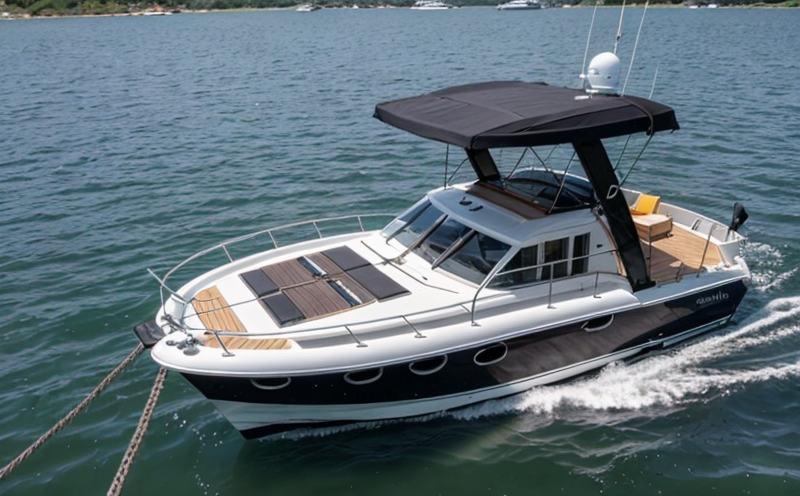ISO 17897 Bending Resistance Testing of Fairleads
The bending resistance testing per ISO 17897 is a critical procedure for ensuring the durability and safety of fairleads used in marine and ship equipment. This test evaluates how well a fairlead can withstand mechanical stress during dynamic loading, which is essential given the harsh environments where these components operate.
Marine fairleads are subjected to significant forces due to the constant movement and wear associated with mooring lines, anchors, and other deck equipment. These forces can cause fatigue or failure of the fairlead, leading to safety hazards on board ships and offshore structures. The ISO 17897 test provides a standardized method for assessing this resistance.
The testing process involves subjecting the fairlead specimen to a series of bending cycles until failure occurs. This allows manufacturers and quality assurance teams to determine the fatigue strength and durability of their products, ensuring compliance with international standards like ISO 17897:2015.
During preparation for testing, the fairlead is cleaned thoroughly using appropriate solvents and degreasing agents to remove any contaminants that might affect test results. The specimen is then mounted onto a specially designed jig which simulates real-world loading conditions but in controlled laboratory settings.
The bending resistance test apparatus typically consists of hydraulic or pneumatic systems capable of applying cyclic loads at specified frequencies and amplitudes. These tests can be conducted under either static or dynamic load conditions depending on the application requirements.
After conducting numerous cycles, engineers observe for signs of damage such as cracks, deformation, or loss in tensile strength until failure occurs. The point at which failure happens provides valuable insights into the fatigue life and ultimate strength capabilities of each fairlead model.
The results from this type of testing are crucial not only during product development stages but also for ongoing quality control measures within production facilities. By adhering to international standards such as ISO 17897:2015, companies demonstrate their commitment to maintaining high-quality standards and ensuring safety at sea.
Understanding the importance of this test allows stakeholders like procurement officers or R&D engineers better insight into why it's necessary. For instance, understanding how different materials behave under varying levels of stress can inform decisions about material selection for future products.
Why Choose This Test
The ISO 17897 bending resistance test is particularly valuable because it offers a reliable means to evaluate the durability and fatigue strength of fairleads. This information ensures that marine equipment meets stringent safety requirements without compromising performance.
For quality managers responsible for overseeing product development processes, this test provides critical data points needed during design iterations. It helps identify potential weaknesses early on so that necessary improvements can be made before full-scale production begins.
Compliance officers benefit greatly from such tests as they ensure adherence to relevant international standards like ISO 17897:2015, thereby avoiding penalties associated with non-compliance. Additionally, it builds trust among customers who value safety and reliability in their purchasing decisions.
R&D engineers can leverage the results of these tests when innovating new designs or materials for fairleads. They gain deeper knowledge about how various factors influence performance metrics, which aids in creating more efficient and robust products.
Customer Impact and Satisfaction
The impact of ISO 17897 bending resistance testing extends beyond internal operations; it significantly enhances customer satisfaction by delivering safer, higher-quality marine equipment. When manufacturers adhere to these standards, they demonstrate a commitment to excellence that resonates with discerning customers.
For end-users aboard vessels or offshore platforms, peace of mind comes from knowing that critical components like fairleads have undergone rigorous testing. This reduces the risk of failures during operation, which can lead to accidents and costly downtime.
The testing process also helps in meeting regulatory requirements set by maritime authorities worldwide. Compliance with these standards builds credibility among regulatory bodies and fosters a positive reputation for brands operating within this sector.
International Acceptance and Recognition
The acceptance of ISO 17897:2015 has been widely recognized across the global maritime industry. Its adoption ensures consistency in testing methods worldwide, promoting fair competition among manufacturers who adhere to these standards.
Many leading companies in the marine equipment sector have implemented this test as part of their quality control protocols. By doing so, they signal their dedication to producing reliable products that meet international safety benchmarks.
In addition to enhancing brand image and customer trust, following ISO 17897:2015 also opens up opportunities for exporting products internationally. Many countries mandate compliance with such standards before allowing imports from overseas suppliers.





